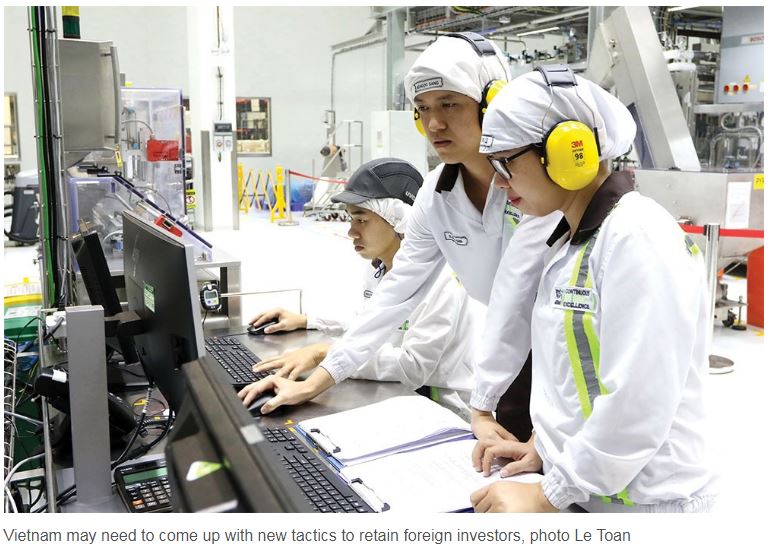Vietnam: Gains feasible through large-scale FDI
The second annual report on foreign investment in Vietnam for 2022 released earlier in March by the Vietnam’s Association of Foreign Invested Enterprises noted that the United States has decreased corporate income tax from 25 to 21 per cent, while also reforming investment licensing procedures. In addition, the US government is applying higher taxes on imported products to increase the competitiveness of several industrial sectors, such as energy, automobiles, steel, and aluminium.
Besides that, the US is also promoting a “prosperous economic network” that connects allied countries to build supply chains of products such as semiconductors and 5G-related technology.
In Europe, some countries such as Germany and Italy have also unveiled policies to limit investment in overseas markets, while France is encouraging its enterprises to expand their operation in high-value sectors, such as automobiles, aviation, and digital technology.
Japan and South Korea, the top two foreign investors in Vietnam, are also applying significant policies that are encouraging their companies to seek investment opportunities at home. Notably, Japan has spent $2 billion supporting Japanese manufacturers to return their production from China.
The moves raise concerns about foreign direct investment (FDI) inflows to Vietnam this year.
Looking at US alone, the Ministry of Planning and Investment reported that as of February 20, the total US registered capital in Vietnam reached $11.42 billion for 1,223 valid projects, making the US the 11th-largest foreign investor in Vietnam. It boasts massive names present in Vietnam, including Coca-Cola, Apple, Google, and Intel with billion-dollar ventures.
Meanwhile, the largest German investments have been implemented by other big names. Bosch is employing a major manufacturing complex for push belts in the southern province of Dong Nai, while also operating a research and development centre in Ho Chi Minh City. Stada-Pymepharco manufactures pharmaceuticals in its factory in the central province of Phu Yen, while Messer is supplying gas to local customers such as Hoa Phat from its main production hubs in Quang Ngai province in Central Vietnam and Hai Duong province in the north. Germany’s total registered investment capital in Vietnam is $2.34 billion.
Italy ranks ninth among EU investors in Vietnam, with the registered capital of $452.4 million. The majority of investment is wholly owned by Italian companies, mostly in pharmaceuticals, transport, machinery, and foodstuffs.
For example, in February, Piaggio Vietnam Co. Ltd., raised its investment in the northern province of Vinh Phuc by $75 million to $165 million to raise motorcycle production and assembly capacity to 400,000 products annually from 250,000. Engine production will also rise to 400,000 units annually from 300,000.
Despite efforts from their governments to encourage home investment, organisations here said there is still a basis for Vietnam to balance this fluctuation with large-scale capital inflows.
John Rockhold, chairman of the American Chamber of Commerce in Hanoi (AmCham), said that US enterprises will still pay attention to the investment environment in Vietnam, especially in the green growth sector.
“US investors are prospecting opportunities to invest in green energy, especially wind power, logistics, seaport infrastructure, and railways with a scale of billions of dollars,” he said.
Traditional investors in Vietnam such as China, South Korea, Japan, and Singapore also have new moves lined up. On March 8, the leaders of Thai Nguyen People’s Committee and Sunny Group from China signed an MoU on the implementation of an industrial complex in the province.
The group has plans to build Sunny Group Industrial Centre that could expand to 40 hectares in Yen Binh Industrial Zone of Pho Yen city, with the total investment up to $2.5 billion. The target is to manufacture camera lenses, optical equipment for cars, and other optical products. The centre would be the second-largest foreign-invested project in the province, following a $7 billion Samsung facility, and could also become a magnet to lure satellite suppliers.
Sunny Group began operating a facility to manufacture, process, and assemble camera module optics, which was put into operation in March 2022 in Thai Nguyen province in the north.
Meanwhile, at a meeting with the leadership of Binh Duong People’s Committee on March 9, Dong Hoon Huyn, chairman of SEP Group, said based on the carbon-neutral model being piloted by Banwol-Sihwa Industrial Complex in South Korea, SEP wants to develop a carbon-neutral industrial complex specialised in shoemaking and infrastructure to reduce carbon. The complex is set to cover 180ha in Phu Giao district, capitalised at $200 million.
To effectively garner more foreign inflow, especially from the US, Rockhold from AmCham proposes closer interaction with the State Bank of Vietnam and the Ministry of Finance to create a better mechanism for American investors when they enter Vietnam. “To attract projects in terms of green energy, the authority should offer incentive lending rates. The existing lending rate is uncompetitive,” he said.
He added that to attract FDI in wind power investment in the next decade, for example, the government needs to complete the legal framework for funding in this field, such as approving the Power Development Plan VIII, building a bidding mechanism, issuing new feed-in tariff prices, and simultaneously utilising a pilot application of direct electricity purchase as well as sale mechanisms.
Source: VIR


 English
English




